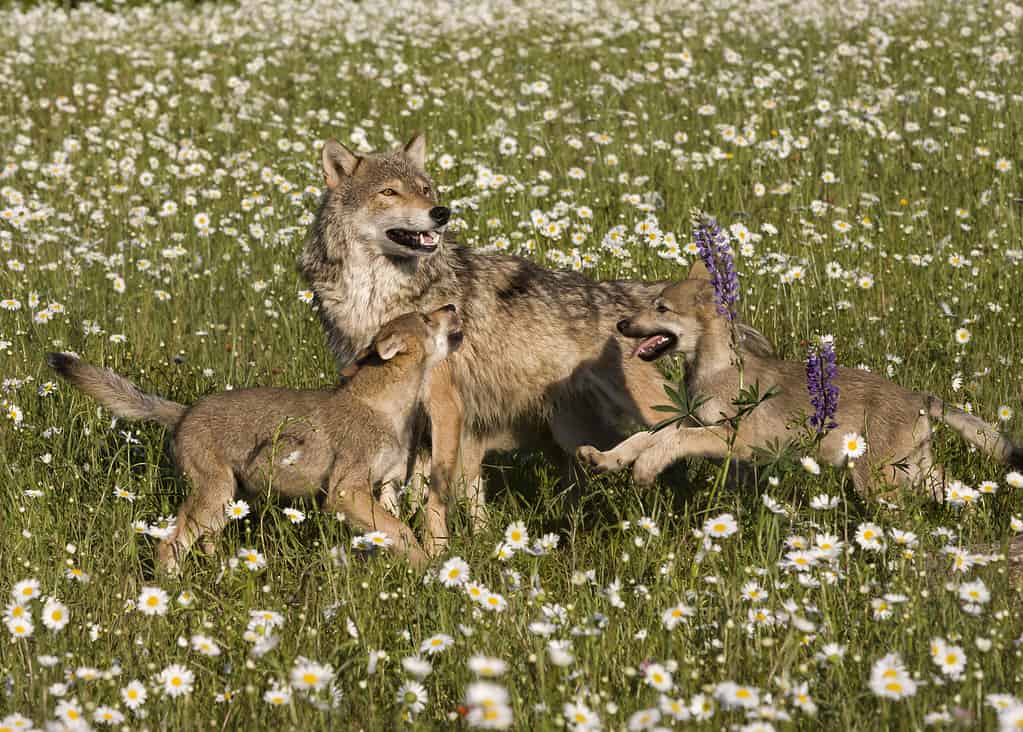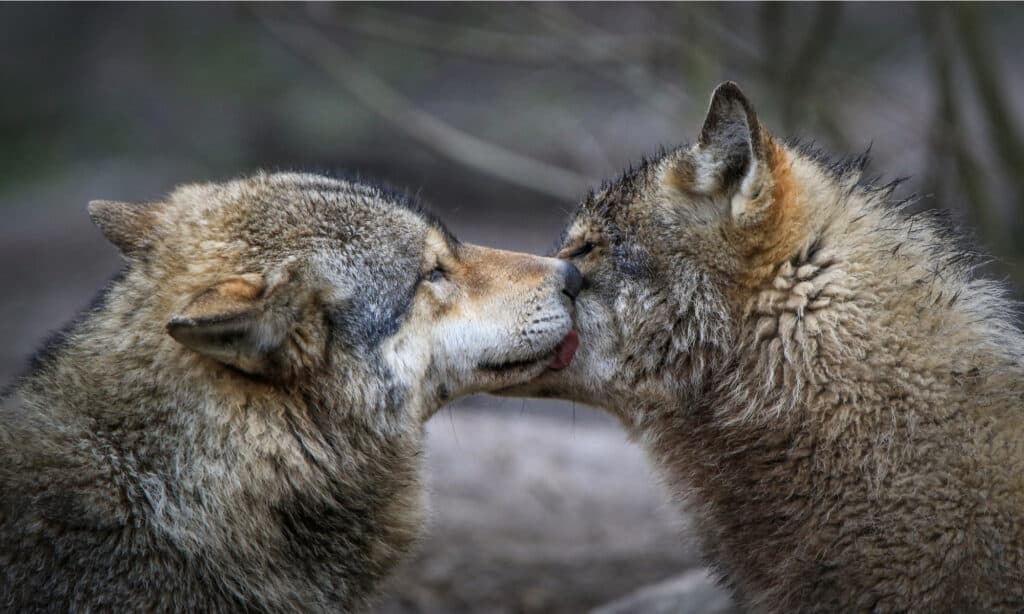Researchers have studied wolf communication for many decades. However, some of these studies, especially prior to the 2000s, come from observations of captive wolves in man-made packs. Conflicts between wolves in captive settings tend to occur much more frequently due to space restrictions, non-kinship-based packs, and other stressors caused by captive living. In the past decade or so, researchers have increasingly focused their observations on free-ranging wolves.
In this guide, we’ll delve into the question of how wolves communicate based on modern research on free-ranging wolves. Read on to learn more!
How Do Wolves Communicate: Acoustic Communication
Like the domestic dog, wolves (Canis lupus) are vocal communicators. They can produce a wide range of sounds to express themselves and communicate with each other. These vocalizations include growls, howls, whimpers, whines, snarls, barks, squeals, and yelps. This vocal communication serves to identify the location of pack members, communicate emotions and intents between conspecifics, resolve conflict, facilitate movement during hunting and other activities, and maintain group cohesion and social bonding.
Howling
One study published in 2012 analyzed the howls of five different free-ranging wolf packs from the province of Arezzo, Italy. The researchers hypothesized that each pack would have distinctive vocal signatures in their howls. These vocal signatures would allow pack members to recognize each other over long distances. Indeed, the researchers found that each pack had a unified and distinctive vocal signature and that this signature remained stable over two consecutive years of study. During hunts, wolves don’t tend to vocalize frequently, but they will howl to determine each other’s locations when hunting over a spread-out area.

Wolf packs appear to have unique signatures in their howls to aid in identification over long distances.
©Thomas Barrat/Shutterstock.com
Defensive or Aggressive Vocalizations
Wolves are extremely adept at ritualized aggression, in which animals display threatening gestures without engaging in actual physical conflict. These displays allow conflict to be resolved without the heightened risk of serious injury or death. Primarily, the vocalizations during ritualized aggression between pack members are growling, snarling, and agitated barking. These signals act as a warning and are often emphatic requests for space. For example, a wolf enjoying a meaty bone may give a low warning growl to another pack member who is getting too close to her coveted snack. If this warning is not heeded, the low growl may escalate to snarling and air snapping. Only when several attempts at communication fail does a healthy wolf resort to true injury-causing fighting between pack mates.
Appeasing and Affectionate Vocalizations
Vocalizing appeasement and affection aids in maintaining and strengthening pack cohesion and social harmony. Wolves may whimper and whine to show appeasement to another pack member. These vocalizations can de-escalate potential conflict and show a willingness to cede space and resources. A wolf excited at the arrival of a pack member or when initiating play may also whimper and whine. When playing, wolves may also grumble, bark, and growl cheerfully.
How Do Wolves Communicate: Body Language
Body language is a core aspect of wolf communication. The position of the tail, ears, and body can send a range of signals.
Imposing Body Language
Imposing body language may occur during conflict over resources, access to mating, new interactions, and access to preferred spaces. A wolf may present with an erect, sometimes stiffly wagging tail, stiff body, fur standing up along the neck and back, forward-positioned ears, and a tense facial expression. If an interaction begins to escalate, the wolf may bare their teeth and stare.

Teeth-baring is part of ritualized aggression in wolves.
©karlumbriaco/iStock via Getty Images
Appeasing Body Language
A wolf showing appeasement to another may position himself low to the ground with flattened ears and a low or tucked tail. The tail may be still or quickly wagging in an anxious expression. He may look away from the other wolf, yawn, and lick his lips. Rolling onto the side or back may also occur as a request for space or a sign of harmlessness.
Playful and Affectionate Body Language
When expressing playfulness, a wolf displays much of the same body language as a domesticated dog. They may play bow, wag their tails in a relaxed and fluid manner, display a relaxed or excited expression, and move in a dance-like or playfully jumpy manner.

Playful body language in wolves is relaxed and dance-like.
©dssimages/iStock via Getty Images
How Do Wolves Communicate: Tactile Communication
Wolves can communicate a range of emotions and intentions through tactile interactions. Playfulness, aggression, affection, appeasement, and defensiveness can all be expressed through tactile interactions.
Ritualized Aggression in Tactile Communication
Sometimes, ritualized aggression may escalate to physical contact, although injury-causing conflict is still not present. A wolf may use bite inhibition to enact a non-injury-causing bite against another pack member. The wolf might also position their neck over the other or place their paw on the back of the other wolf. Wolves can also use body checking to assert themselves.
Playful and Affectionate Tactile Communication
During greetings, friendly wolves may lick each other’s faces, rub cheeks, gently bump with their noses, and mouth each other’s muzzles. They also snuggle, nuzzle, and paw at each other to show affection. Wolf pups will also engage in these behaviors with their mother.

Friendly wolf greetings include face licking, nuzzling, and mouthing each other’s muzzles.
©Pat-s pictures/Shutterstock.com
The photo featured at the top of this post is © RamiroMarquezPhotos/iStock via Getty Images
Thank you for reading! Have some feedback for us? Contact the AZ Animals editorial team.







